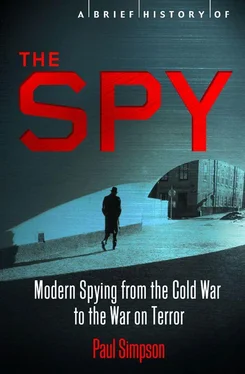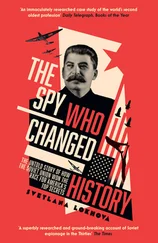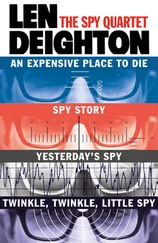Paul Simpson - A Brief History of the Spy
Здесь есть возможность читать онлайн «Paul Simpson - A Brief History of the Spy» весь текст электронной книги совершенно бесплатно (целиком полную версию без сокращений). В некоторых случаях можно слушать аудио, скачать через торрент в формате fb2 и присутствует краткое содержание. Город: London, Год выпуска: 2013, ISBN: 2013, Издательство: Constable & Robinson, Жанр: Прочая документальная литература, на английском языке. Описание произведения, (предисловие) а так же отзывы посетителей доступны на портале библиотеки ЛибКат.
- Название:A Brief History of the Spy
- Автор:
- Издательство:Constable & Robinson
- Жанр:
- Год:2013
- Город:London
- ISBN:9781780338910
- Рейтинг книги:3 / 5. Голосов: 1
-
Избранное:Добавить в избранное
- Отзывы:
-
Ваша оценка:
- 60
- 1
- 2
- 3
- 4
- 5
A Brief History of the Spy: краткое содержание, описание и аннотация
Предлагаем к чтению аннотацию, описание, краткое содержание или предисловие (зависит от того, что написал сам автор книги «A Brief History of the Spy»). Если вы не нашли необходимую информацию о книге — напишите в комментариях, мы постараемся отыскать её.
A Brief History of the Spy — читать онлайн бесплатно полную книгу (весь текст) целиком
Ниже представлен текст книги, разбитый по страницам. Система сохранения места последней прочитанной страницы, позволяет с удобством читать онлайн бесплатно книгу «A Brief History of the Spy», без необходимости каждый раз заново искать на чём Вы остановились. Поставьте закладку, и сможете в любой момент перейти на страницу, на которой закончили чтение.
Интервал:
Закладка:
Cairncross was also at Bletchley at this point early in the Second World War, passing on information about German troop movements, and contributing to the Soviet victory at the Battle of Kursk. In 1944, he then moved across to MI6, working on the German desk at Section V, before moving to the Political Intelligence section, where he didn’t prosper so well, lacking Burgess’ or Maclean’s innate talents for getting along with people easily.
Guy Burgess’ contributions to the Soviet war effort were in a different field, following his dismissal from SOE. He ended up working once more as a talks producer for the BBC, and even managed to get the author of his own inspiration, Ernst Henri, on the air, proclaiming how great the Soviet Union’s intelligence network was!
Maclean was the only one of the Five not to have a distinguished war career — at least at first. He didn’t handle the strain of his double life well, and although he was part of the General Department of the Foreign Office, he seemed to lack energy, not helped by problems with his domestic life. However in Spring 1944, he was posted to Washington DC, and seemed to regain his previous enthusiasm. He had access to information about the Allies’ plans after the war ended, and also became involved with liaison with the atomic-bomb project. His wife was in New York, and he travelled there from Washington regularly to see her — and pass on information to Gorsky, who had crossed to the United States to handle Centre agents there. Of course, this meant that there was signals traffic between the various Soviet missions on the East Coast regarding his movements — something that would come back to haunt Maclean a few years later, and eventually cause the downfall of the entire Cambridge Magnificent Five.
Compared with their British or Russian allies, the Americans were latecomers to the espionage field — partly, of course, because as of the start of the Second World War, the United States as an entity had only existed for just over 150 years.
During the First World War, which America only entered in 1917, the Army’s G-2 section along with the Office of Naval Intelligence (ONI) had operated against pro-German groups, and American cryptologist Herbert O. Yardley helped to organize the US Army’s Cipher Bureau, known as MI-8. This had some notable successes against German agents operating in the US, but its peacetime operations were brought to a close in 1928 when incoming president Herbert Hoover’s new secretary of state Henry L. Stimson shut it down, stating that ‘Gentlemen do not read each other’s mail’.
G-2 and the ONI continued to function between the wars, working in tandem with the newly created Federal Bureau of Intelligence (formerly the Department of Justice Bureau of Investigation) to keep an eye on actual and potential subversive elements, including the Communist Party of the United States of America (CPUSA). It seems they didn’t realize the scale of Soviet infiltration: the daughter of the American ambassador to Germany was an early recruit, while Congressman Samuel Dickstein, a key member of the Special Committee on Un-American Activities, which was seeking to eradicate Nazism in the States, was on the NKVD books during the late thirties, and earned the nickname Crook for his financial demands.
Inevitably there were overlapping operations between the various groups, but it was only after the outbreak of war in Europe in September 1939 that President Roosevelt decided to regularize the situation. In June 1940, internal security was divided between the various parties: the FBI remained in charge of civilian investigations, while G-2 and the ONI dealt with those involving the military (including defence plants that had major Army or Navy contracts). They would also be responsible for the Panama Canal Zone, the Philippines and major Army reservations.
Despite the shutdown of the Cipher Bureau, code-breaking had continued to form a major part of the intelligence work of the US forces, and a debate continues to this day about how much was known by President Roosevelt about the impending attack on Pearl Harbor in December 1941. It seems probable that the president was not aware of the danger, but what is absolutely certain is that the men in charge in Hawaii were not up to speed with everything that Washington knew and didn’t take the appropriate action. The code-breakers would redeem the reputation of their profession by breaking the Japanese code known as JN25, which prevented the invasion of Northern Australia and gave US Fleet Admiral Nimitz a vital edge before the Battle of Midway.
Five months before Pearl Harbor, President Roosevelt appointed William ‘Wild Bill’ Donovan, a successful Wall Street lawyer and Medal of Honor winner, as Coordinator of Intelligence (COI). Donovan had spent the previous year liaising with William Stephenson, the Scottish-Canadian millionaire who became an unofficial channel for British influence in the States following the outbreak of war in Europe. Donovan became convinced that a central coordinated American intelligence agency was required, and his appointment as COI, consulting with the heads of the existing agencies and reporting directly to the president, was a major stepping-stone towards that.
The declaration of war with Japan and Germany in December 1941 led to a division of the COI’s responsibilities, with its propaganda work transferred to the Office of War Information, and the rest incorporated into the new Office of Strategic Services (the OSS). Donovan remained in charge of this new organization, but instead of reporting to the president as formerly, he now answered to the military Joint Chiefs of Staff.
The OSS was split into three divisions: the Special Intelligence division gathered intelligence from open sources, and from agents in the field. Allen Dulles was in charge of a crucial station in Bern, Switzerland, which supplied a lot of vital information regarding the Nazi rocket programme, and the German atomic bomb project. The Special Operations group was an equivalent to the British Special Operations Executive, and carried out many of the same functions, sometimes in tandem with the British, but on other occasions, as in Yugoslavia, working with different groups opposing the Nazis. The Morale Operations division used the radio station Soldat Ensender as a propaganda weapon against the German army. Many senior figures in American intelligence circles after the Second World War were OSS agents, including future CIA chiefs Allen Dulles and William Colby.
Although the FBI were involved with what might be termed traditional activities during the war years — dealing with potential saboteurs and other threats to national security — they did operate their own Special Intelligence Service (confusingly referred to as the SIS by the Bureau) in Latin America. According to the FBI’s own history its role ‘was to provide information on Axis activities in South America and to destroy its intelligence and propaganda networks. Several hundred thousand Germans or German descendants and numerous Japanese lived in South America. They provided pro-Axis pressure and cover for Axis communications facilities. Nevertheless, in every South American country, the SIS was instrumental in bringing about a situation in which, by 1944, continued support for the Nazis became intolerable or impractical.’
At much the same time as the heads of British Intelligence were contemplating what would happen once the Axis was defeated, William Donovan was considering the future for American Intelligence. In a memorandum to President Roosevelt on 18 November 1944 he wrote:
Once our enemies are defeated, the demand will be equally pressing for information that will aid us in solving the problems of peace. This will require two things:
Читать дальшеИнтервал:
Закладка:
Похожие книги на «A Brief History of the Spy»
Представляем Вашему вниманию похожие книги на «A Brief History of the Spy» списком для выбора. Мы отобрали схожую по названию и смыслу литературу в надежде предоставить читателям больше вариантов отыскать новые, интересные, ещё непрочитанные произведения.
Обсуждение, отзывы о книге «A Brief History of the Spy» и просто собственные мнения читателей. Оставьте ваши комментарии, напишите, что Вы думаете о произведении, его смысле или главных героях. Укажите что конкретно понравилось, а что нет, и почему Вы так считаете.












